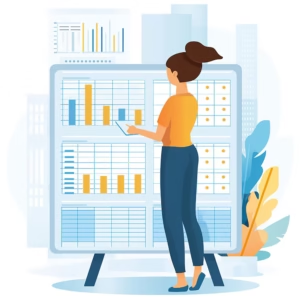

Why Primary Data Isn’t Always the Best Choice for Scope 3.1 Reporting?
Table of Contents
- The Promise and Pitfalls of Primary Data
- 4 Reasons Primary Data Falls Short in Scope 3.1
- When Is Primary Data Worth the Effort?
- What the GHG Protocol and Industry Leaders Recommend?
- Why a Hybrid Approach Delivers the Best of Both Worlds?
- Conclusion
- FAQs
- Is using secondary data compliant with GHG Protocol?
- How do I know which suppliers need primary data?
- What are examples of good secondary data sources?
When it comes to Scope 3.1 emissions reporting, specifically emissions from purchased goods and services, primary data has long been hailed as the gold standard. It's company-specific, granular, and traceable. Sustainability teams, regulators, and investors all view it as the clearest lens into the actual climate impact of a supply chain.
But here’s the truth: in practice, primary data is not always better. In fact, exclusive reliance on it can sometimes compromise speed, accuracy, and comparability.
As pressure increases from frameworks like the GHG Protocol, CDP, ISSB, and CSRD, companies need scalable, audit-ready strategies that strike a balance between ambition and feasibility.
This article explores why primary data, despite its benefits, is not always the right answer for every supplier or category, and why a hybrid model that incorporates high-quality secondary data is often the smarter path forward.
The Promise and Pitfalls of Primary Data
Primary data reflects actual supplier operations. It includes material-level activity data (e.g., electricity used, tons of steel purchased) and company-specific emission factors. Theoretically, it enables:
- Better footprint accuracy
- Source traceability
- Richer supplier engagement
But here’s what often happens in the real world:
- The data never arrives
- It arrives late
- It’s poorly calculated or non-comparable
- You spend months chasing answers from dozens (or thousands) of suppliers
In fact, CDP reported in its 2023 supply chain disclosure that only 41% of suppliers could provide any emissions data at all, and even fewer could share it with confidence or clarity.
So how can companies still move forward responsibly?

4 Reasons Primary Data Falls Short in Scope 3.1
1. Data Availability and Maturity Gaps
Many suppliers, especially SMEs (small and medium enterprises), are not yet equipped to report emissions. According to the OECD, over 90% of suppliers globally fall into this category.
These suppliers may lack:
- Carbon accounting tools
- Internal expertise
- Incentives or regulatory pressure
Pushing them for primary data can result in:
- Long delays
- Inaccurate “guestimates”
- Misrepresented secondary data passed off as primary
In these cases, insisting on primary data may do more harm than good.
2. Inconsistent Methodologies and Boundaries
Even when you receive supplier data, there’s often no standardisation.
Common problems include:
- Different emissions boundaries (e.g., cradle-to-gate vs. gate-to-gate)
- Conflicting assumptions and scope definitions
- Varying units, currency baselines, or conversion methods
This inconsistency makes data difficult to aggregate, compare, or assure—resulting in a patchwork inventory that lacks confidence.
Harmonising all this post-facto requires significant effort, often outweighing the benefits of primary data.
3. High Cost for Low-Impact Suppliers
Let’s say your Tier 3 supplier delivers packaging inserts worth €2,000 annually. The carbon impact is likely minuscule. But collecting and validating emissions data from them might take:
- Multiple emails or meetings
- Support with emissions tools
- Manual QA and documentation
At this point, the cost of precision outweighs its climate value.
Focus your primary data efforts on large, high-impact suppliers instead.
4. Secondary Data Can Be “Good Enough”
High-quality secondary data, such as product-level emission factors from lifecycle inventory databases, can offer:
- Consistency across categories
- Transparent methodology
- Immediate scalability
Reliable sources include:
- ECOVINIENT
- DEFRA
- USEEIO / EXIOBASE
- ADEME
As long as these are applied thoughtfully, adjusted for region, product type, or currency, they deliver decision-useful accuracy that is good enough for most reporting purposes.
Secondary data is not a compromise. It’s a strategy.
When Is Primary Data Worth the Effort?
You should prioritise supplier-specific data when:
- The supplier contributes >5–10% of your upstream emissions
- The purchase category is carbon-intensive (e.g., metals, chemicals, plastics)
- The supplier is strategically important or under regulatory pressure
- Your industry is subject to product-level or customer-level emissions transparency
These cases justify the cost and complexity of primary data efforts.
Want to simplify Scope 3.1 supplier reporting?
What the GHG Protocol and Industry Leaders Recommend?
The GHG Protocol Scope 3 Standard itself recognises the limitations of primary data. It encourages companies to use:
- Supplier-specific data for high-priority goods
- Secondary data or emission factors for less material categories
- A documentation trail for all data types and assumptions
Leaders like Unilever, Dell, and GM are adopting tiered data strategies that reflect these principles, using hybrid models to scale without sacrificing credibility.

Why a Hybrid Approach Delivers the Best of Both Worlds?
A hybrid approach helps you:
- Focus your resources on the most material sources of emissions
- Scale emissions accounting across thousands of SKUs or suppliers
- Build a credible, improvable emissions baseline
- Stay compliant with CSRD, SEC climate rule, and CDP guidance
Mavarick helps automate this hybrid approach—flagging suppliers that require primary data while auto-applying vetted emission factors elsewhere.
Conclusion
Primary data is important, but it’s not everything.
It’s time to move away from the perfection myth. Chasing primary data for every purchase may slow you down, increase your costs, and introduce unnecessary complexity. Worse, it may leave you stuck in a cycle of delay and inaction.
Instead, use a risk- and materiality-based framework:
- Prioritise primary data where it matters most
- Rely on high-quality secondary data elsewhere
- Build a transparent, improvable baseline over time
With the right strategy, you can reduce emissions and reporting friction, without compromising on credibility.
FAQs
Is using secondary data compliant with GHG Protocol?
Yes. The GHG Protocol encourages the use of high-quality secondary data, especially when primary data is unavailable or unreliable.
How do I know which suppliers need primary data?
Use a materiality threshold—e.g., focus on suppliers contributing to the top 80% of Scope 3.1 emissions.
What are examples of good secondary data sources?
DEFRA (UK), ecoinvent, EXIOBASE, USEEIO, and ADEME are trusted, regularly updated sources.
Carbon Accounting System
Carbon Emissions Reporting for the Supply Chain
- Visible Supply Chain
- Quality Data You can Trust
- Auditable Reports
